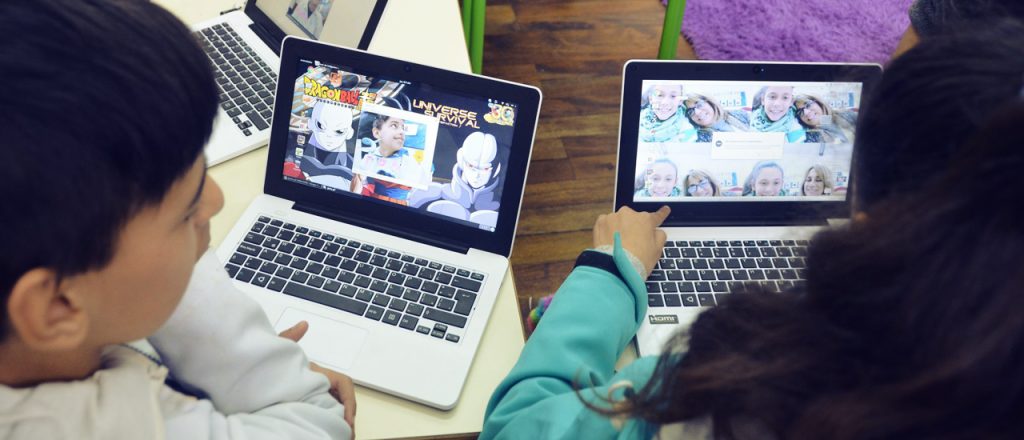Nokia Names Fixed Networks Biz Leader, Access Networks Remains Headless
 Sandra Motley was named president of the Fixed Networks Business organization. She previously served as COO of that group and will now report directly to Nokia President and CEO Rajeev Suri.
Sandra Motley was named president of the Fixed Networks Business organization. She previously served as COO of that group and will now report directly to Nokia President and CEO Rajeev Suri.
Flor de Ceibo Conecta2: Sharing Experiences

Today’s guest author is María Julia Morales González, the “Flor de Ceibo Conecta2” project manager and a professor at the Department of Sociology and Interdisciplinary Space of the University of the Republic Uruguay.
The Internet Society Uruguay Chapter, in partnership with the The University of the Republic and the Consejo de Formación en Educación, as well as with financial support from the Beyond the Net Funding Programme, has taken significant steps to help children and teenagers to develop digital skills in a creative and innovative way in three of the nineteen segments in which Uruguay is politically divided: Paysandú, Rivera, and Salto. Their project Flor de Ceibo Conecta2 aims to train young people from disadvantaged communities using digital resources in creative and challenging classes to help them improve their everyday lives and expand their chances for a better future.
Hoy queremos acercarles 2 experiencias que estamos transitando en el Proyecto Flor de Ceibo Conecta2.
Una de ellas se desarrolla en la ciudad de Salto en el liceo N° 7 del Barrio Artigas, zona de alta vulnerabilidad. Allí el equipo está trabajando en el uso de redes sociales y en particular en este taller en referencia al uso de whatsapp.
SK Telecom Gets the 5G Ball Rolling in 2019
 The 5G juggernaut rumbles on with South Korea getting a headstart on announcements in the new year. Meanwhile, posts on Reddit indicate AT&T's 5G is underwhelming, so far.
The 5G juggernaut rumbles on with South Korea getting a headstart on announcements in the new year. Meanwhile, posts on Reddit indicate AT&T's 5G is underwhelming, so far.
History Of Networking – EVPN – Rahul Aggarwal
Outro Music:
Danger Storm Kevin MacLeod (incompetech.com)
Licensed under Creative Commons: By Attribution 3.0 License
http://creativecommons.org/licenses/by/3.0/
The post History Of Networking – EVPN – Rahul Aggarwal appeared first on Network Collective.
The Week in Internet News: India Pushes for Sites to Remove ‘Unlawful’ Content, Break Encryption

Not this again: India’s government wants websites and social media platforms to remove content regulators determine as “unlawful” within 24 hours and to create automated tools to identify this material, BuzzFeed reports. The government also wants the tech companies to trace the source of the content, requiring platforms like WhatsApp to break encryption. This follows passage of an Australian law that forces online services to provide the government there with encryption workarounds.
The Wire of India defends the proposal, however, saying it’s aimed at holding websites and social media platform more responsible for the content they distribute.
More blocking: The government of Sudan has shut down most Internet access in the country and blocked access to social media platforms, Rogue Media Labs says. The government blamed the shutdown on massive protests over income inequality and other issues.
Missed assignments: In a related story, some college students in the Indian region of Kashmir have missed deadlines for submitting online application forms of their bachelors of education examination because of frequent and lengthy Internet shutdowns there, reports Kashmir Reader. Students are asking the University of Kashmir to extend its deadline.
Blockchain vs. national security? An ex-CIA official is targeting blockchain, saying the Continue reading
SDxCentral’s Top 10 Articles of 2018
 Cisco lays off hundreds in California; Cisco updates its routers with SD-WAN; and all the details of Verizon's outsourcing deal.
Cisco lays off hundreds in California; Cisco updates its routers with SD-WAN; and all the details of Verizon's outsourcing deal.
Smart Data: The Secret Weapon Underpinning the Cloud
By applying the insights of smart data, businesses can add strategic value from the cloud, while also gaining the flexibility, agility, and scalability needed to remain competitive.
2019 Is The King of Content
2018 was a year full of excitement and fun. And for me, it was a year full of writing quite a bit. Not only did keep up my writing here for my audience but I also wrote quite a few posts for GestaltIT.com. You can find a list of all the stuff I wrote right here. I took a lot of briefings from up-and-coming companies as well as talking to some other great companies and writing a couple of series about SD-WAN.
It was also a big year for the Gestalt IT Rundown. My co-host with most Rich Stroffolino (@MrAnthropology) and I had a lot of fun looking at news from enterprise IT and some other fun chipset and cryptocurrency news. And I’ve probably burned my last few bridges with Larry Ellison and Mark Zuckerberg to boot. I look forward to recording these episodes every Wednesday and I hope that some of you will join us on the Gestalt IT Facebook page at 12:30 EST as well.
Content Coming Your Way
So, what does that leave in store for 2019? Well, since I hate predictions on an industry scale, that means taking a look at what I Continue reading
CircleCI, Docker and Systemd
I have been battling to get the combination of CircleCI, Docker and systemd to play together. After much frustration, I have a workable solution. Machine Executor, privileged: true, cgroup passthrough, and disabling AppArmor.
Background: CircleCI for Ansible Linting & Checks
In the StackStorm team we use CircleCI with most of our repositories. We check things like code style checks, and run unit tests. With every Pull Request we trigger these checks, and checks must pass before merging. Some repos also use CircleCI for post-merge deployment steps.
We use Ansible and Terraform to manage some of our internal infrastructure. All configurations are stored in Git. All changes to that configuration must be submitted as a Pull Request. All PRs need approval, and all commit checks must pass. We use CircleCI to run these commit checks.
We run multiple checks, but for Ansible playbooks, they include using ansible-lint, and ansible-playbook --syntax-check. We then spin up a Docker container using CircleCI and run some of our playbooks twice, checking that it passes both times, and that the second run records no changes.
Here’s a snippet of some of our CircleCI configuration:
version: 2
jobs:
build:
working_directory: Continue readingCircleCI, Docker and Systemd
I have been battling to get the combination of CircleCI, Docker and systemd to play together. After much frustration, I have a workable solution. Machine Executor, privileged: true, cgroup passthrough, and disabling AppArmor.
Background: CircleCI for Ansible Linting & Checks
In the StackStorm team we use CircleCI with most of our repositories. We check things like code style checks, and run unit tests. With every Pull Request we trigger these checks, and checks must pass before merging. Some repos also use CircleCI for post-merge deployment steps.
We use Ansible and Terraform to manage some of our internal infrastructure. All configurations are stored in Git. All changes to that configuration must be submitted as a Pull Request. All PRs need approval, and all commit checks must pass. We use CircleCI to run these commit checks.
We run multiple checks, but for Ansible playbooks, they include using ansible-lint, and ansible-playbook --syntax-check. We then spin up a Docker container using CircleCI and run some of our playbooks twice, checking that it passes both times, and that the second run records no changes.
Here’s a snippet of some of our CircleCI configuration:
1
2
3
4
5
6
7
8
9
Continue reading
CircleCI, Docker and Systemd
I have been battling to get the combination of CircleCI, Docker and systemd to play together. After much frustration, I have a workable solution. Machine Executor, privileged: true, cgroup passthrough, and disabling AppArmor.
Background: CircleCI for Ansible Linting & Checks
In the StackStorm team we use CircleCI with most of our repositories. We check things like code style checks, and run unit tests. With every Pull Request we trigger these checks, and checks must pass before merging. Some repos also use CircleCI for post-merge deployment steps.
We use Ansible and Terraform to manage some of our internal infrastructure. All configurations are stored in Git. All changes to that configuration must be submitted as a Pull Request. All PRs need approval, and all commit checks must pass. We use CircleCI to run these commit checks.
We run multiple checks, but for Ansible playbooks, they include using ansible-lint, and ansible-playbook --syntax-check. We then spin up a Docker container using CircleCI and run some of our playbooks twice, checking that it passes both times, and that the second run records no changes.
Here’s a snippet of some of our CircleCI configuration:
1
2
3
4
5
6
7
8
9
Continue reading
Keep Pace with Network Infrastructure Tech Changes in 2019
Here is a quick overview of the key infractructure technologies that will imapct your networks in the coming year.
NAT64Check Version 2 is launched!

With the New Year comes the launch of NAT64Check version 2 from the Internet Society. The first version of NAT64Check was introduced a couple of years ago and has proved very popular and successful, so for the past year we’ve been working on a number of enhancements in response to feedback and requests. And we’re very happy to be able to make the new version available as we welcome in 2019.
NAT64Check is a tool developed by the Internet Society in collaboration with Stichting IPv6 Nederland, Go6, SJM Steffann, Internetbureau Max and Simply Understand. This allows you to enter the URL of a particular website, and then run tests over IPv4, IPv6 and NAT64 in order to check whether the website is actually reachable in each case, whether identical web pages are returned, and whether all the resources such as images, stylesheets and scripts load correctly. It also compares responsiveness using the different protocols, therefore allowing network and system administrators to easily identify anything is ‘broken’, to pinpoint where any non-IPv6 compatible elements need to be fixed.
 The original version of NAT64Check though, ran on two separate servers at Go6 and the IPv6 Lab which each had a limited view of the Internet Continue reading
The original version of NAT64Check though, ran on two separate servers at Go6 and the IPv6 Lab which each had a limited view of the Internet Continue reading